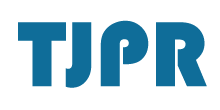
 |
||
| Tropical Journal of Pharmaceutical Research | ||
| Official Journal of Pharmacotherpy Group | ||
| Home | Pharmacotherapy Group | African Journals Online |
Prescribing
practices in two health care facilities in Warri, Southern Nigeria: A
comparative study
Patrick O ErahF, GO Olumide and Augustine O Okhamafe
Pharmacotherapy Group, Faculty of Pharmacy, University of Benin, Benin City, Nigeria
Tropical Journal of Pharmaceutical Research 2003; 2(1): 175-182
Abstract
Purpose:
Inappropriate
prescribing has been identified in many health facilities in developing
countries. The purpose of this study was to evaluate the prescribing practices
in two health care facilities in Warri located in south-south geopolitical
region of Nigeria and identify factors influencing the practices.
Method:
WHO Prescribing Indicators
were applied to evaluate 2000 prescription records, retrospectively, from a
private and a public hospital in Warri. Factors influencing the prescribing
practices in the facilities were identified through informal interviews of 10
prescribers in the facilities. Using a self-administered questionnaire
administered to 40 prescribers in the facilities, we also evaluated the order of
importance of the factors affecting drug prescribing.
Results:
Average number of drugs per
encounter in the health facilities is 3.4 (3.9 in the public hospital and 2.8 in
the private hospital). Generic prescribing was generally low (54% in the public
hospital and 16% in the private hospital) while the percentage of encounters
with antibiotics prescribed was high (75% in the public hospital and 55% in the
private hospital). Antimalarials, antihypertensives, antidiarrhoeals and
analgesics accounted for 47.4%, 7.5%, 1.0% and 18.2%, respectively. The overuse
of drugs and generic prescribing were significantly lower in the private
hospital than in the public hospital. Major
factors influencing prescribing practices included drug availability,
clinician’s level of training, cost of drugs, feedback from patients and
socio-economic status of patients.
Conclusion:
Polypharmacy, overuse of
antibiotics and low rate generic prescribing still occur in the health
facilities studied. Drug availability, clinician’s level of training, cost of
drugs, feedback from patients and socio-economic status of patients are major
factors influencing prescribing in the facilities.
Keywords:
Drug prescribing, Indicators, Practices, Southern Nigeria
FTo
whom correspondence should be addressed:
E-mail:
erah@uniben.edu
Tel::
+234 802 336 0318
| @2002-3. TJPR Faculty of Pharmacy, University of Benin, Benin City, Nigeria |
| Tel: +234 802 3360318 Fax: +234 52 602257 E-mail: okhamafe@uniben.edu erah@uniben.edu p_erah@yahoo.com |
| Last updated: August 19, 2003 |